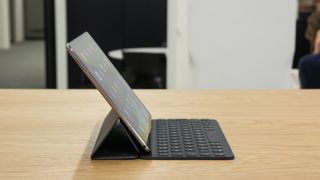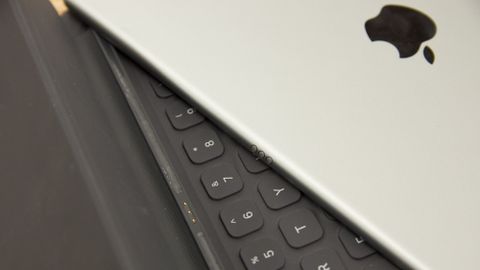IT Pro Verdict
A screen upgrade would have been enough to net the new iPad Pro a perfect score, but the fact that Apple has stuffed in a host of additional upgrades means it's impossible not to recommend it. It's definitely top of the tree, easily the best product in its category and arguably one of the best products all-round that Apple has ever made.
Pros
- +
Superb screen; Outstanding performance; Excellent battery life
Cons
- -
Expensive; Still not quite the laptop replacement for everyone; iOS 11 isn’t out yet
With the iPad Pro, Apple has spent years trying to convince the world that a tablet can act as a genuine replacement for your laptop. Previous iterations never quite managed to convince us that an iPad could function as well as a laptop, particularly for business users.
That may have changed with the latest generation of iPad Pro, however. Apple has overhauled the display, fitted it with a powerful new processor and promised some seriously impressive productivity and functionality upgrades when iOS 11 hits devices. But can the new and improved iPad Pro family really cut it as a fully-fledged laptop replacement?
Who uses the iPad Pro?
Before we delve into the details of the product, it's worth thinking about how the iPad range has been deployed in the enterprise. There's essentially two scenarios: one where an iPad acts as a secondary device - a 'carry around' - when the user has a bigger laptop or desktop computer; and one where the iPad acts as the user's sole device. This latter scenario sounds like it's less common, but Apple has actually had some success in pitching the iPad Pro as a device for field workers and certain office-based employees.
As a secondary device, the iPad Pro's main competition is probably from high-end Android tablets like the Samsung Galaxy Tab S3. However, in the latter scenario the competition is mainly from Windows convertibles like Microsoft's own Surface Pro series.

So with this in mind, how does the latest iPad Pro fare against both these kinds of competition, and in both scenarios? Let's look at how the device shapes up.
iPad Pro: Design, display and specs
If you're expecting a radical redesign of the iPad with the latest models in the Pro range, you'll be disappointed. They're very much still iPads, and follow the same design formula that we're all familiar with. The iPad design is iconic, which is partly why it hasn't really changed since the iPad Air.
The only slight variations to the previous generation of iPad Pro are some minor adjustments to weight, thickness and the size of the screen bezels - all of which are practically negligible. The 10.5in model is a couple of millimetres thicker and around 30g heavier than the 9.7in version it replaces (which is to be expected, given the larger footprint and screen size), while the bigger 12.9in version is around 30g lighter than its predecessor.
Both devices still feel light and comfortable to use, and are excellently-balanced in the hand. The 12.9in version can be slightly unwieldy due to the sheer size of it, but this is easily fixed by pairing it with a stand or folio case.
The real improvements aren't cosmetic though - they're under the hood. Apple has updated all the key elements of the tablet, starting with the screen. The TrueTone display on the iPad Pro 9.7in was already the best screen we'd seen on any device, but Apple hasn't been content to rest on its laurels. Instead, it's ramped up the refresh rate to a maximum of 120Hz, which makes things like scrolling much more responsive. It's also introduced a feature that it's calling ProMotion, which allows it to run the screen at a lower refresh rate if fast motion isn't happening on screen.

ProMotion sounds a little gimmicky, but it's not: it's probably the best thing to happen to mobile screens since the dawn of the retina era. It makes that much difference to how smooth everything looks on screen. There's none of the lag you associate with swiping around on cheaper screens.
This faster refresh rate also contributes to a more responsive experience with the Apple Pencil, which now has a response time of just 20ms - a whole millisecond less than the latest iteration of the Surface Pen. Also contributing to this is some smart code behind the scenes which uses machine learning to predict where the Pencil will move next, and literally "draw ahead" by a millisecond or two. A trained artist we asked for an opinion described the Pencil as easily the most responsive on-screen drawing experience they had ever used, and the first which came close to paper.
If that was all Apple had done, it would be a decent upgrade. But there's more: a lot more. The processor has been updated to the new Apple A10X Fusion ARM chip, which, as we'll see, pushes performance even further. The 32GB configuration is gone, with the range now running 64GB, 256GB, and 512GB, something which sounds crazy for a tablet but which makes complete sense if you're considering the iPad as a genuine laptop replacement.
And of course, Apple being Apple, it had to update the camera too, which is now the same 12MP unit as on the current iPhone 7, widely regarded as amongst the best phone cameras in the world. You might only ever use this for scanning documents - and in conjunction with apps like Office Lens the iPad makes a great document scanner - but you'll get some really good results.
- 1
- 2
Current page: Apple iPad Pro review: Apple quietly hikes prices of some iPad Pro models
Next Page

